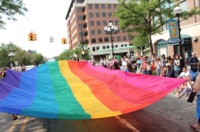Sexual Orientation
The “Model Minority” is Heterosexual
The model minority myth rests on the idea that what is considered “normal.” This means one should be as close to being white as possible. This also means that the “model minority” must fit into other normative labels, which specifically includes being heterosexual and cisgender. The model minority myth masks the persistent inequivalent experiences within the Asian American community, especially those who identify as LGBTQ (Lesbian Gay Bisexual Transgender Queer). Despite their history to the contrary, homosexuality and other forms of sexualities are seen as “deviant” today in most Asian/ American spaces, even in activist circles (Otalvaro-Hormillosa). Having these combined marginalized identities make queer Asian Americans more vulnerable by the white, heterosexual majority, particularly noticeable in the form of work discrimination, policing and sexual assault (Eng and Hom).
The LGBTQ community had been an invisible presence until the later half of the 20th century. They began to get national attention in the United States only after the Stonewall Riots in Manhattan in 1969. The riots were a series of spontaneous violent demonstrations by members of the LGBTQ community after a police raid of a predominantly gay bar in Greenwich Village. As a mechanism to harass people belonging to the LGBTQ community, the police often raided establishments that were suspected to harbor people identifying as LGBTQ. (Stewart Winter). The events at Stonewall sparked increased activism within the LGBTQ movement; activists marched, protested, and began pursuing court cases that would constitutionally grant them their rights (Frank). The LGBTQ movement was influenced by the actions taken during the Civil Rights movement, with its activists often being an ally to the LGBTQ community. Despite being perceived as separate movements, the Civil Rights movement and the LGBTQ movement intersected with each other closely. In his book, Queer Clout, Stewart Winter discusses how the LGBTQ community faced police raids and brutality at multiple gay bars in Chicago, as the black community also faced similar raids. This created empathy between the two marginalized groups due to their shared experiences of harassment from the police. For example, black activists often worked with the LGBTQ community to reduce job discrimination and address harassment from the police .
Despite the inspiration from the Civil Rights Movement, the LGBTQ movements in the 70s and 80 did have divisions particularly on the grounds of race. The LGBTQ activists were often white men and women belonging to the middle class, causing a tension between queer white communities (WQC) and queer people of color (QPOC) (Stewart-Winter). The discrimination the WQC faced was different from QPOC as the former community had the intersection of their race added into their marginalization. This “double burned” endured by QPOC was perceived to have not been completely acknowledged by leaders of the queer movements and their voices were often muffled by the activism for marriage equality when there were people who were faced discrimination solely based on the color of their skin.
Within Asian diasporas (and in general), there is an unequal power relationship existing between members of the same diaspora, especially those identifying as queer, because queerness is seen as a challenge to heteronormativity. Asian/Pacific Islander queers find themselves balancing between multiple identities without necessarily having the privilege to occupy each particular space. They were unable to make up the dominant culture within the mainstream white gay male culture and they are unable to voice themselves within traditionally heterosexist Asian-Pacific culture (Eng and Hom). This led to multiple Asian American LGBTQ organizations being formed on the East and West Coasts in the 1970s and 80s for the purpose of creating a network and community of support for people interested. The Asian American LGBTQ community notably organized in the Bay area around California’s Proposition 187 in 1994 which denied education, healthcare and social services to individuals suspected of being undocumented immigrants (Eng and Hom). This revealed how the community not only came together, but supported connecting causes such as anti-racist work and immigration work as they recognized the importance of including all narratives to get the liberation they desire.
The LGBTQ movement was also impacted by the rising AIDS crisis during the 80s under the Reagan Administration. AIDS became associated with gay men, and became known as a “Gay Disease.” Prominent gay activists, such as Jim Toy (see page on Jim Toy), became deeply involved in the anti-discrimination work related to AIDS crisis and especially its public perception. As the term “Gay Disease” spread, there was a widespread fear of contacting the disease through physical contact (Frank). This lead to job, school and housing discrimination (among others) towards men perceived as being gay. as This fear endured despite the U.S. center for Disease Control and Prevention (CDC) publicly stated in 1983 that AIDS could not be transmitted through physical contact. Activists within the gay community began to create education centers and advocated for increased government funding to research the disease and what causes it. Activists and lawyers also fought to ensure that people could not be discriminated against if they are found to have the disease. This continued advocacy by the LGBTQ community ensured that people identifying as queer would have reduced discriminatory experiences in certain circumstances, though the network still faced prejudice from numerous institution, such as the University of Michigan.
References
Frank, Walter. Law and the Gay Rights Story: The Long Search for Equal Justice in a Divided Democracy. New Brunswick: Rutgers University Press, July 2014. Project Muse.
Sonia Otalvaro-Hormillosa. The Homeless Diaspora of Queer Asian Americans. Social Justice, Vol. 26, No. 3 (77), Beyond National: Identities, Social Problems & Movements (Fall 1999), pp. 103-122.
Stewart-Winter, Timothy. Queer Clout: Chicago and the Rise of Gay Politics. Philadelphia: University of Pennsylvania Press, 2017.
Urofsky, Melvin I. Supreme Decisions: Great Constitutional Cases and Their Impact. Boulder, CO: Westview Press, 2012.
https://www.michiganradio.org/post/untold-story-gay-rights-movement-detroit

